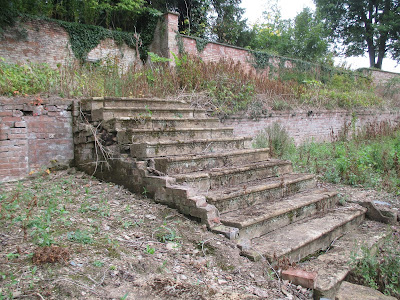A couple of weeks ago P and I had a wonderful day out. We felt like exploring somewhere new, so decided on the Somerset Levels, an amazing watery landscape, low-lying, drained and managed by humans over the centuries. It is criss-crossed by channels of water and is prone to regular flooding.

There are little hills like Glastonbury Tor, or this one, Burrow Mump, which used to be island settlements in a swampy landscape.

There are little hills like Glastonbury Tor, or this one, Burrow Mump, which used to be island settlements in a swampy landscape.
Nowadays the land is used for grazing and apple-growing, and is full of little orchards like this one.
We visited the Willow and Wetlands Centre, and I was amazed at the sheer number of uses that humans have woven willow for: eel traps, fishing baskets,
bird cages, furniture,
household storage and containers,
bath chairs, mail sorting boxes, and even coffins and plane seats. The list went on and on.
There were so many garden supports and sculptures, that I came away with a bundle of withies, inspired to do some willow-weaving myself.
We walked through the woods underneath a stunning willow hawk
down to the willow beds, waterlogged fields full of this year's withies.
Water channels known as rhynes were crossed by little bridges,
and all around was lush and verdant, dotted here and there with spires of purple loosestrife.
Such a different landscape.
From here we drove on to Fyne Court, a National Trust property to the west. Once a large house and landscaped garden , the house burnt down many years ago and the grounds remain.
The courtyard houses a cafe and the place was full of families with children, as there is something very different about this property.
It has been allowed to remain in a state of wildness, carefully neglected so that visitors can walk, play and picnic there. Fallen trees were climbed upon.
The walled kitchen garden was strangely bare, in the process of a change of purpose.
Ruined steps led to an overgrown terrace.
Plants grew out of walls.
Ferns, moss and ivy proliferated.
Above a pond-dipping area which was full of delighted children with nets, another pond lay still and bright green, eerily quiet.
A ruined boathouse was being reclaimed by nature, the leat running past it full of water mint. There was a silence punctuated only by the quiet passage of people walking through the pathways, exploring.
I have never been more reminded of one of my favourite poems, Walter De La Mare's 'The Listeners':
''Is there anybody there?' said the Traveller,
Knocking on the moonlit door.
And his horse in the silence champed
The grasses of the forest's ferny floor...
But no one descended to the Traveller;
No head from the leaf-fringed sill
Leaned over and looked into his grey eyes,
Where he stood perplexed and still.'
Before long the sun came out, shining through the beech, sweet chestnut and horse chestnut leaves overhead and lighting everything up around us a luminous green.
We were glad we'd visited this unusual and interesting place.
We drove further westwards, on into the Quantock Hills near the border between North Somerset and Devon, and came to Great Wood, an old hunting forest, full of towering Scots pines.
In a central grassy area there were many families enjoying the holidays and warm weather having barbeques and splashing in the little stream.
We sat on the bank, eating apples and took off our shoes and socks for a paddle. It was rather stony, but the water was so cool on a hot day that we didn't mind at all.
The stream babbled its way down from the hills and lulled us as we sat and listened to it.
The sunlight filtered through the trees and lit up the little grasses all around us.
By now we were hungry and stopped at a shop in a nearby village for provisions, heading on up into the hills to a viewpoint we knew would be a good place to stop, Staple Plain. Up and up we went away from the sweet villages and wooded valleys with a steep drop to one side, and arrived on the top of the hill.
The landscape had changed again to beautiful wild heathland. It was early evening on an overcast but warm day, and the hillside was at its best, covered in heather and gorse in bloom.
Here we sat and ate bread rolls and cheese on a bench, with the most glorious view to feast our eyes upon.
I love this kind of landscape in late summer, high moors and hills stained with purple and yellow, and everywhere the bracken turning rusty colours. It epitomises late summer holidays for me, and makes me realise how much I love days out and holidays in these sorts of places.
We walked to the top of the hill and stood and drank in the scenery.
A few woolly inhabitants passed us by, going about their everyday business.
Solitary windblown silver birches and rowan trees dotted the hillside.
And all around heathery hues and bright coccnut-scented gorse. Heaven.
It was past seven o'clock now, and the horizon was becoming hazy. Time to wend our way home again. We said goodbye to the Quantock Hills and were home again just as darkness fell. It had been a truly lovely day out, a special one we'll remember.
These high moors and hills inspire me hugely, and the heathery late summer colours make me think of tweeds and tartans in soft greens and mauves, russets and deep blues. I'll leave you with a little watercolour painting I made a couple of years ago after a visit to Exmoor at this time of year. I painted it in a rush, trying to capture the colours of heather-clad hillsides and blue skies.
I hope you are enjoying the end of your summer too, and will see you soon x



























































